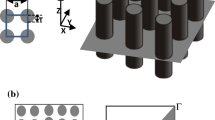Summary
A continuum approach, based on the principles of modern extended thermodynamics, describing the model of a phonon gas is performed. The main difference with the ideal phonon gas theory consists in the presence of athermal inertia. We apply the shock wave theory and discuss the selection rules for physical shocks (theLax conditions and theentropy growth). In this way the existence of two new kinds of shocks (hot andcold shocks) in rigid heat conductors at low temperature is pointed out. In particular a critical temperature, characteristic of each material, changing the structure of the previous types of shocks is analytically deduced. This characteristic temperature permits also to explain the modification of the received second sound wave form with respect to the initial wave profile. Finally, the results are applied to the case of high-purity crystals (NaF, Bi,3He and4He) and compared with experimental results.
Similar content being viewed by others
References
V. Peshkov:J. Phys. USSR,8, 381 (1944).
L. Landau:J. Phys. USSR,5, 71 (1941).
V. Peshkov: inReport on an International Conference on Fundamental Particles and Low Temperature Physics, Vol. II (The Physical Society of London, 1947), p. 19.
C. C. Ackerman, B. Bertman, H. A. Fairbank andR. A. Guyer:Phys. Rev. Lett.,16, 789 (1966).
C. C. Ackerman andW. C. Overton jr.:Phys. Rev. Lett.,22, 764 (1969).
H. E. Jackson, C. T. Walker andT. F. McNelly:Phys. Rev. Lett.,25, 26 (1970)
V. Narayanamurti andR. C. Dynes:Phys. Rev. Lett.,28, 1461 (1972).
R. A. Guyer andJ. A. Krumhansl:Phys. Rev. Lett.,148, 766, 778 (1966).
C. Cattaneo:Atti Sem. Mat. Fis. Univ. Modena,3, 83 (1948).
This velocity remains still valid when the non-linear terms are taken into account.
W. Larecki andS. Piekarski:Nuovo Cimento D,13, 31 (1991);W. Larecki:Nuovo Cimento D,14, 141 (1992).
G. M. Kremer andI. Müller:J. Math. Phys.,33, 2265 (1992).
T. Ruggeri, A. Muracchini andL. Seccia:Phys. Rev. Lett,64, 2640 (1990);T. Ruggeri:Mod. Phys. Lett. B,4, 945 (1990).
I-Shih Liu andI. Müller:Arch. Rat. Mech. Anal.,83, 285 (1983);I-Shih Liu, I. Müller andT. Ruggeri:Ann. Phys.,169, 191 (1986);I. Müller:Thermodynamics (Pitman, Boston, Mass., 1985);I. Müller andT. Ruggeri (Editors):Kinetic Theory and Extended Thermodynamics (Pitagora, Bologna, 1987);I. Müller andT. Ruggeri:Extended Thermodynamics, Springer Tracts on Natural Philosophy., Vol.37 (Springer-Verlag, New York, N.Y., 1993).
T. Ruggeri:Boll. Un. Mat. Ital. Suppl., Fisica Matematica,4, 261 (1985);Rend. Sem. Mat. Univ. Torino, Hyperbolic Equations, 167 (1987) (special issue);A. Morro andT. Ruggeri:Int. J. Non-Linear Mech.,22, 27 (1987).
A. Morro andT. Ruggeri:J. Phys. C,21, 1743 (1988).
T. Ruggeri andA. Strumia:Ann. Inst. H. Poincaré,34, 65 (1981).
T. Ruggeri:Continuum Mech. Thermodyn.,1, 3 (1989).
B. D. Coleman, M. Fabrizio andD. R. Owen:Arch. Rat. Mech. Anal.,80, 135 (1982).
P. D. Lax:Comm. Pure Appl. Math.,10, 537 (1957).
In terms of unperturbed and perturbed Mach numbers (M r=s/λr andM l=s/λv, respectively) the Lax conditions are equivalent to the well-known conditions, arising in fluid dynamics, that the shock is supersonic on one side (M r>1), and subsonic on the other one (M l<1).
Of course it is possible to have cases in which\(\bar \mu \to \infty \). In this circumstance we do not have other bifurcations points except the pointA (e.g., the fluid dynamics).
P. D. Lax:Contributions to the Theory of Partial Differential Equations (Princeton University Press, Princeton, N.J., 1954);G. Boillat:La propagation des ondes (Gauthier-Villars, Paris, 1965);G. Boillat andT. Ruggeri:Boll. Un. Mat. Ital. A,15, 197 (1978).
The Lax conditions play several roles in non-linear wave propagation; in particular, for the causality in the impact between a discontinuity wave and a shock wave see,e.g.,G. Boillat andT. Ruggeri:Proc. R. Soc. Edinburgh A,83, 17 (1979);L. Brun: inMechanical Waves in Solids, edited byJ. Mandel andL. Brun (Springer, Wien, 1975).
A. Jeffrey:Quasilinear Hyperbolic Systems and Waves (Pitman, London, 1976).
P. D. Lax: inContribution to Non Linear Functional Analysis, edited byE. H. Zarantonello (Academic Press, New York, N.Y., 1971);G. Boillat:C.R. Acad. Sci. Paris A,283, 409 (1976).
A discussion of the selection rules and, more in general, of the questions related to the Riemann problem can be seen inC. Dafermos:Arch. Rat. Mech. Anal.,107, 127 (1989) and in the references therein quoted.
B. D. Coleman andD. C. Newman:Phys. Rev. B,37, 1492 (1988). The same general features of shock propagation are obtained if we use only the experimental values or a different interpolation function.
It does not seem easy to verify that this property remains valid also in the general theory of shock waves.
W. Narayanamurti andR. C. Dynes:Proceedings of the XIV International Conference on Low Temperature Physics, Vol.1 (North-Holland, New York, N.Y., 1976), p. 499.
C. C. Ackerman andR. A. Guyer:Ann. Phys.,50, 128 (1968).
I-Shih Liu:Arch. Rat. Mech. Anal.,46, 131 (1972).
Author information
Authors and Affiliations
Rights and permissions
About this article
Cite this article
Ruggeri, T., Muracchini, A. & Seccia, L. Continuum approach to phonon gas and shape changes of second sound via shock waves theory. Il Nuovo Cimento D 16, 15–44 (1994). https://doi.org/10.1007/BF02452000
Received:
Accepted:
Issue Date:
DOI: https://doi.org/10.1007/BF02452000




